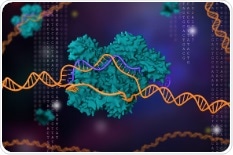Researchers from the University of Maryland (UMD) are using CRISPR technology in an effort to develop first-of-their-kind microelectronic devices that link with biological systems.
The researchers’ aim is to use this technology in a unique way to electronically switch “on” and “off” many genes at the same time.

3D rendering of CRISPR technology. Image Credit: Stock image.
The method, published in the Nature Communications journal, has the ability to further close the gap between the biological and electronic worlds, paving the path for new “smart” and wearable devices.
Faced with the COVID-19 pandemic, we now have an even deeper understanding of how ‘smart’ devices could benefit the general population.”
William E. Bentley, Professor in Fischell Department of Bioengineering, Institute for Bioscience and Biotechnology Research, University of Maryland
Bentley is also the director of the Robert E. Fischell Institute for Biomedical Devices.
Bentley continued, “Imagine what the world would be like if we could wear a device and access an app on our smartphone capable of detecting whether the wearer has the active virus, generated immunity, or has not been infected. We don’t have this yet, but it is increasingly clear that a suite of technologies enabling the rapid transfer of information between biology and electronics is needed to make this a reality.”
By using such a device, this data could be used, for instance, to autonomously and dynamically perform effective contact tracing.
In the last six decades, microelectronics have considerably advanced from the first implantable pacemaker to personal wearable devices that use the power of interrelated computing devices, also called the Internet of things or IoT.
The upcoming wave of microelectronics could comprise devices that tap into molecules and control them, such as hormones, DNA, or glucose—to improve human health. Yet, a major roadblock continues to persist.
Despite the potential level of advancements seen in today’s smart devices, modern microelectronic devices process data using materials like chemicals, gold, or silicon, as well as an energy source that supplies electrons.
However, there are no free electrons in biological systems. Hence, a technology gap still exists between the biological world and the microelectronics.
More than two years ago, Bentley, his IBBR and Fischell Institute collaborator, Gregory F, Payne, and their groups published a study on a loophole discovered by them.
A small class of molecules, which have the ability to shuttle electrons, already exists in biological systems.
The molecules, called “redox” molecules, can deliver electrons to any kind of location. To perform this, the redox molecules must initially undergo a sequence of chemical reactions, reduction or oxidation reactions, to deliver the electrons to the planned target.
Bentley’s research team developed an advanced synthetic “switching” system in bacterial cells by engineering cells with synthetic biology components. This system detects electrons rather than the more conventional molecular signals and integrates the biologically programmable genetic circuitry of CRISPR.
CRISPR control functions are popularly known for gene editing and they were altered to function with SoxR, a regulatory protein that reacts to redox molecules and is present in E. coli. The researchers did not edit the genes; instead, they used the CRISPR technology to focus the metabolic machinery of a cell to perform the required functions.
The team’s process involves the so-called upregulation and downregulation, in which a cell either increases (upregulation) or decreases (downregulation) the quantity of a specific component, for example, a protein, in response to an external stimulus.
Using CRISPR, the researchers successfully proved that they could electrically program the downregulation and upregulation of particular genes present in both E. coli and Salmonella. In this manner, the researchers demonstrated that information programmed electrically could be conveyed to and within different bacterial strains using the same redox medium as a communication channel.
Furthermore, the researchers developed and used the CRISPR technology to leverage the signal processing capabilities in telecommunications and electronics. The team immobilized the cells in a gel and applied electronic signals to develop a distinct chemical gradient of the CRISPR-controlling extracellular signal.
The scientists demonstrated that cells subjected to the most highly oxidized pyocyanin, a metabolite that can take part in a redox reaction, exhibited the highest level of CRISPR activity, whereas the cells subjected to minimally oxidized pyocyanin showed the lowest level of CRISPR activity.
In doing so, the scientists successfully supported their concept that electrical signals could be utilized to spatially regulate the CRISPR technology.
While the CRISPR technology is believed to be an agile tool in the field of biology, this study provides the first evidence of how CRISPR can be employed in bioelectronics to electronically target and regulate the select genes at the same time.
Our next steps involve ramping up our bioelectronics work so that the next generation communication devices can indeed incorporate biological information that is obtained locally.”
William E. Bentley, Professor in Fischell Department of Bioengineering, Institute for Bioscience and Biotechnology Research, University of Maryland
Source:
Journal reference:
Bhokisham, N., et al. (2020) A redox-based electrogenetic CRISPR system to connect with and control biological information networks. Nature Communications. doi.org/10.1038/s41467-020-16249-x.